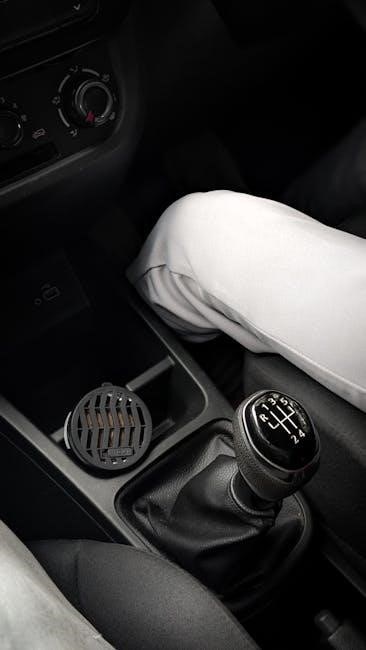The Utah Driver’s Manual is a comprehensive guide detailing driving rules, road safety, and licensing procedures․ It prepares applicants for tests and ensures safe driving practices․ Available as a PDF on the Utah DMV website, it’s updated regularly to reflect current laws and regulations․

Types of Driver’s Licenses in Utah
Utah offers various driver’s licenses, including Class D for standard vehicles, Commercial Driver’s Licenses (CDL) for large vehicles, and Motorcycle Licenses for two-wheelers․ Each serves specific driving needs․
Class D License
The Class D License in Utah is the standard driver’s license for operating non-commercial vehicles․ It is required for driving passenger cars, light trucks, and other non-commercial vehicles․ To obtain a Class D License, applicants must be at least 16 years old, pass a vision test, and complete a written knowledge test․ Additionally, they must pass a driving skills test to demonstrate their ability to operate a vehicle safely․ The license is valid for five years and must be renewed before expiration․ Applicants under 18 may need to complete a driver’s education course or provide proof of driving experience․ The Class D License is essential for legal driving privileges in Utah․
Commercial Driver’s License (CDL)
A Commercial Driver’s License (CDL) in Utah is required to operate large commercial vehicles, such as trucks, buses, and vehicles carrying hazardous materials․ The CDL program ensures drivers meet higher safety and skill standards․ There are three classes: Class A for combination vehicles, Class B for heavy straight trucks, and Class C for small passenger vehicles or hazardous materials․ Applicants must be at least 21 years old, pass a medical exam, and complete a skills test․ Additional endorsements are needed for specific cargo or vehicle types․ The CDL is essential for professional drivers and is regulated by both state and federal guidelines to maintain road safety․
Motorcycle License
In Utah, obtaining a motorcycle license requires specific steps and qualifications․ Riders must be at least 16 years old to apply for a motorcycle endorsement․ A vision test, written knowledge test, and motorcycle skills test are mandatory․ The Utah Driver’s Manual provides detailed information on motorcycle safety, road rules, and operating techniques․ Applicants under 18 must complete a motorcycle safety course approved by the Utah Department of Public Safety․ The motorcycle endorsement can be added to a Class D license, allowing operation of motorcycles and mopeds․ Riders are encouraged to wear protective gear and follow traffic laws to ensure safe driving practices on Utah roads․

Rules of the Road
The Utah Driver’s Manual outlines essential traffic rules, including obeying signals, right-of-way procedures, and speed limits․ It emphasizes defensive driving and safe practices to prevent collisions․
Traffic Signals and Signs
Traffic signals and signs are crucial for maintaining order and safety on Utah roads․ The manual explains various types, including regulatory signs like stop signs and speed limits, warning signs indicating hazards, and guide signs providing directional information․ Understanding these signals is essential for safe driving and preparing for the driver’s test․ The manual also covers pedestrian signals and bicycle-related signs, ensuring all road users are informed․ By following these guidelines, drivers can navigate Utah’s roads confidently and responsibly, contributing to a safer driving environment for everyone․ The manual emphasizes the importance of obeying all traffic signals and signs to prevent accidents and violations․
Right-of-Way Rules
Right-of-way rules in Utah are designed to ensure smooth traffic flow and prevent accidents․ The manual outlines scenarios where drivers must yield, such as at four-way stops, uncontrolled intersections, and when pedestrians cross․ Drivers turning left must always yield to oncoming traffic; Emergency vehicles, like ambulances and fire trucks, have priority when their lights and sirens are active․ Understanding these rules is critical for safe driving and passing the driver’s test․ The manual emphasizes courtesy and awareness to avoid conflicts and ensure all road users navigate safely․ By following right-of-way guidelines, drivers contribute to a harmonious and accident-free driving environment in Utah․
Speed Limits
Speed limits in Utah are established to ensure safety on roads and highways․ The manual outlines maximum speeds for urban areas, school zones, and rural highways․ Speed limits vary based on road conditions and traffic density․ Drivers must adhere to posted signs, as exceeding limits can result in fines or penalties․ The manual emphasizes adjusting speed according to weather, visibility, and traffic flow․ Understanding and following speed limits is crucial for reducing accidents and ensuring the safety of all road users․ By complying with these regulations, drivers contribute to a safer and more orderly transportation system in Utah․

Safe Driving Practices
Safe driving practices in Utah emphasize maintaining a safe distance, staying alert, and adjusting speed according to road conditions․ Always follow traffic laws and use safety features like seat belts to minimize risks and ensure a secure driving environment․
Defensive Driving Techniques
Defensive driving techniques are essential for safe road navigation․ They involve staying alert, maintaining a safe distance, and being aware of surroundings․ Always anticipate potential actions of other drivers and adjust your speed accordingly․ Use mirrors and check blind spots frequently to stay informed․ Avoid distractions like using phones while driving․ Be cautious in adverse weather conditions and reduce speed when necessary․ Defensive driving also includes yielding the right-of-way when appropriate and following traffic signals․ By adopting these practices, drivers can significantly reduce the risk of accidents and ensure a safer environment for all road users․ These techniques are thoroughly covered in the Utah Driver’s Manual to promote responsible driving habits․
Sharing the Road with Other Vehicles
Sharing the road with other vehicles requires respect, awareness, and patience․ Always maintain a safe distance from cars, trucks, and motorcycles․ Be mindful of blind spots, especially for larger vehicles like buses and semi-trucks․ When driving near cyclists or pedestrians, give them ample space and yield when necessary․ Use turn signals to communicate your intentions clearly․ Avoid aggressive maneuvers, such as cutting off other drivers or weaving in and out of lanes․ Courtesy and cooperation are key to reducing congestion and preventing accidents․ The Utah Driver’s Manual emphasizes the importance of treating all road users with respect to ensure a harmonious and safe driving environment for everyone․
Night Driving Tips
Night driving requires extra caution due to reduced visibility and increased risks․ Always reduce your speed and use low beams when approaching other vehicles to avoid blinding drivers․ Keep your windshield and headlights clean to improve visibility․ Avoid distractions, such as using your phone, and stay alert for pedestrians or animals on the road․ If another driver’s high beams are bothering you, look toward the right side of the road to maintain focus․ Never drive if overly tired, as fatigue increases accident risks․ The Utah Driver’s Manual recommends these practices to enhance safety during nighttime driving conditions․
Licensing Requirements and Procedures
Obtaining a Utah driver’s license involves meeting eligibility criteria, completing an application, and passing vision, knowledge, and driving tests․ A medical evaluation may also be required․
Eligibility Requirements
To apply for a Utah driver’s license, applicants must meet specific eligibility criteria․ These include being at least 16 years old for a provisional license and 17 for a full license․ Proof of identity, residency, and legal status in the U․S․ is required․ Applicants under 18 must provide parental consent․ Vision tests are mandatory, and certain medical conditions may require additional documentation․ Utah also requires proof of driving experience for original licenses, ensuring applicants have completed the necessary training or practice hours․ These requirements are outlined in the Utah Driver’s Manual to ensure compliance with state driving laws and regulations․
Application Process
The application process for a Utah driver’s license involves several steps․ Applicants must visit a Utah DMV office and provide required documents, such as proof of identity, residency, and legal status․ A vision test is administered, and applicants must pass a written knowledge test covering traffic laws and signs․ For applicants under 18, parental consent is required․ Fees for the license and testing must be paid․ Once all requirements are met, applicants receive a permit or license, depending on their age and driving experience․ The process is detailed in the Utah Driver’s Manual to guide applicants through each step efficiently․
Vision and Medical Requirements
The Utah Driver’s Manual outlines specific vision and medical requirements for obtaining a driver’s license․ Applicants must meet minimum visual acuity standards, with or without corrective lenses, and have adequate peripheral vision․ Those with certain medical conditions, such as epilepsy or diabetes, may need to provide medical clearance․ A vision test is typically administered during the application process․ Medical requirements ensure that drivers are physically capable of operating a vehicle safely․ Failure to meet these standards may result in restrictions or denial of a license․ These requirements are in place to protect public safety and are strictly enforced by the Utah DMV․

Traffic Laws and Violations
Utah’s traffic laws outline rules for safe driving, including speed limits, right-of-way, and prohibited actions․ Violations can result in fines, penalties, or license suspension, ensuring road safety․
Common Traffic Violations
Common traffic violations in Utah include speeding, running red lights, reckless driving, and failure to yield․ These offenses often result in fines, points on a driver’s license, or even suspension․ Speeding is particularly prevalent, with penalties increasing for excessive speeds․ Reckless driving, such as weaving in and out of lanes or tailgating, poses significant risks and carries harsher consequences․ Additionally, failing to obey traffic signals or stop signs is a frequent violation․ Understanding these common infractions is crucial for drivers to avoid penalties and maintain road safety․ The Utah Driver’s Manual emphasizes the importance of adhering to these laws to prevent accidents and ensure public safety․
Consequences of Traffic Offenses
Traffic offenses in Utah can lead to fines, license points, and even suspension․ Minor violations, like speeding, may result in fines and added points on a driver’s record․ Accumulating too many points can lead to license suspension or mandatory driving classes․ More severe offenses, such as reckless driving or DUI, carry harsher penalties, including higher fines, license revocation, and potential jail time․ Additionally, insurance rates often increase following a conviction․ Understanding these consequences emphasizes the importance of adhering to traffic laws to avoid legal and financial repercussions․ The Utah Driver’s Manual outlines these penalties to encourage responsible driving and road safety․
DUI Laws in Utah
Utah has strict DUI laws to ensure road safety․ The legal blood alcohol content (BAC) limit is 0․05%, lower than many states․ A first-time DUI offense can result in fines, up to 180 days in jail, and a 120-day license suspension․ Repeat offenses lead to harsher penalties, including longer jail sentences and extended license revocation․ Additionally, drivers may be required to install an ignition interlock device․ Underage drivers face zero-tolerance policies, with penalties for any detectable alcohol level․ The Utah Driver’s Manual emphasizes the severity of DUI consequences, encouraging responsible driving and adherence to these laws to protect all road users․
Special Driving Conditions
Utah’s diverse climate requires drivers to adapt to winter driving, inclement weather, and emergency situations․ The manual provides tips for navigating snowy roads and unexpected conditions safely․

Winter Driving Tips
Winter driving in Utah requires extra caution due to snowy and icy conditions․ The manual advises drivers to slow down, increase following distance, and use winter tires․ Always keep a safe distance from snowplows and avoid passing them․ Sudden movements should be avoided to maintain control on slippery roads․ Use low beams in heavy snow to improve visibility without blinding others․ Carry an emergency kit with blankets, a flashlight, and ice scraper․ Know how to handle skidding by steering calmly in the direction of the skid․ Stay informed about weather conditions before driving and plan routes accordingly for safer travel during winter months․
Driving in Inclement Weather
Driving in inclement weather requires heightened caution and awareness․ The Utah Driver’s Manual emphasizes reducing speed and increasing following distance to account for reduced visibility and longer stopping times․ Use headlights in low-light conditions to improve visibility for other drivers․ Avoid sudden movements, such as hard braking or sharp turns, which can lead to loss of control․ Be aware of hydroplaning risks on wet roads and maintain a safe distance from large vehicles to avoid spray․ Keep windshield wipers and defrosters in good condition to ensure clear visibility․ Stay alert for changing weather conditions and consider delaying travel if conditions become too hazardous․

Emergency Procedures

In case of an emergency, the Utah Driver’s Manual advises drivers to remain calm and take immediate action to ensure safety․ If a vehicle becomes disabled, move to the side of the road or a safe location, and turn on hazard lights to alert other drivers․ Call for emergency assistance if necessary․ In the event of a breakdown, stay inside the vehicle with seat belts fastened until help arrives․ For medical emergencies, prioritize seeking immediate care․ Always keep an emergency kit in the vehicle, including items like a first-aid kit, flashlight, and reflective triangles․ Familiarize yourself with these procedures to handle unexpected situations effectively․

Driver Responsibilities and Safety
Drivers must prioritize safe practices, adhere to traffic laws, and maintain vehicle safety․ Regular checks ensure proper function, while awareness promotes a secure driving environment for all road users․
Vehicle Maintenance
Regular vehicle maintenance is crucial for safety and performance․ The Utah Driver’s Manual emphasizes checking tires, brakes, lights, and fluids regularly․ Ensuring proper function of all vehicle systems helps prevent accidents and breakdowns․ Drivers should also address any issues promptly to maintain roadworthiness․ Additionally, Utah requires emissions testing for certain vehicles to reduce pollution․ Proper maintenance not only protects the driver but also other road users․ Neglecting maintenance can lead to unsafe conditions and potential legal consequences․ Staying proactive with vehicle care is a key responsibility for all drivers in Utah․
Seat Belt and Safety Laws
Utah’s seat belt laws require all drivers and passengers to wear a seat belt while the vehicle is in motion․ Enforcement is strict, and violations can result in fines․ The Utah Driver’s Manual highlights that seat belts significantly reduce the risk of fatal injuries in accidents․ Children under age 8 must use a booster seat, while those under 16 must wear a seat belt regardless of seating position․ Utah follows a primary enforcement policy, allowing officers to stop vehicles solely for seat belt violations․ Exceptions exist for medical conditions with a doctor’s note․ Compliance is crucial for safety and legal adherence․
Insurance Requirements
In Utah, drivers must carry minimum liability insurance coverage of $25,000 for bodily injury per person, $65,000 per accident, and $15,000 for property damage․ The Utah Driver’s Manual emphasizes that proof of insurance must be carried in the vehicle at all times․ Drivers caught without insurance face penalties, including fines and license suspension․ Utah follows a no-fault insurance system, but this does not eliminate the need for liability coverage․ Insurance companies must be licensed in Utah, and policies must meet state requirements․ For more details, refer to the official Utah DMV website or consult the Utah Driver’s Manual․
Resources for Drivers
The Utah Driver’s Manual is available as a free PDF on the Utah DMV website․ It includes practice tests, study materials, and information on driver’s education courses․
Where to Find the Utah Driver’s Manual
The Utah Driver’s Manual is readily available on the official Utah DMV website as a free downloadable PDF․ This comprehensive guide covers essential driving rules, road safety tips, and licensing requirements․ It is regularly updated to reflect current traffic laws and regulations․ Drivers can access the manual at any time, making it a convenient resource for study and reference․ The PDF format allows users to easily navigate through sections such as rules of the road, safe driving practices, and licensing procedures․ Whether you’re a new driver or need a refresher, the manual is an invaluable tool for ensuring safe and legal driving in Utah․
Practice Tests and Study Materials

To prepare for the Utah driver’s license test, numerous practice tests and study materials are available․ The Utah DMV offers official practice tests online, covering topics like traffic laws, road signs, and safe driving practices․ Additionally, the Utah Driver’s Manual itself serves as a primary study resource, detailing essential information for both written and driving exams․ Online platforms provide interactive quizzes and flashcards to reinforce learning․ These materials are designed to help applicants understand and master the content, ensuring they are well-prepared for the tests and confident in their ability to drive safely and responsibly in Utah․
Driver’s Education Courses
Driver’s education courses in Utah are designed to teach new drivers the skills and knowledge needed to operate a vehicle safely․ These courses cover topics such as traffic laws, road signs, and defensive driving techniques․ Many programs combine classroom instruction with behind-the-wheel training, ensuring a comprehensive learning experience․ The Utah Driver’s Manual serves as a key resource for these courses, providing detailed information on state-specific driving regulations․ Completing a driver’s education course can also help reduce insurance rates and improve driving confidence․ Online and in-person options are available, making it convenient for learners to prepare for their driver’s license tests and become responsible drivers․
The Utah Driver’s Manual is an essential resource for all drivers, providing detailed information on traffic laws, safe driving practices, and licensing requirements․ It serves as a comprehensive guide for both new and experienced drivers, ensuring they understand their responsibilities on the road․ By following the manual’s guidelines, drivers can reduce risks, avoid violations, and contribute to a safer driving environment․ Regularly reviewing the manual helps stay updated on Utah’s traffic laws and promotes lifelong safe driving habits․ Whether preparing for a license or refreshing knowledge, the Utah Driver’s Manual is a valuable tool for every driver in the state․
